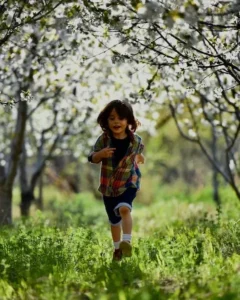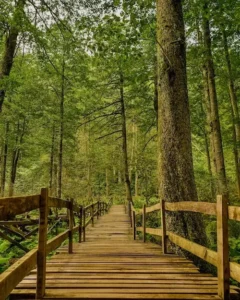Benefits of Trees
Wellness
1. Community (Social well being)
2. Physical and Mental Well-being
3. Aesthetic and visual appeal
4. Recreation
5. Outdoor education
1. Community (Social well being)
- Community cohesion:
- Trees can reduce crime rates
- Crime Prevention through Environmental Design (CPTED)
- Shared stewardship:
- Beautification and identity
- Environmental awareness and advocacy:
Community cohesion: Trees and green spaces serve as gathering places for communities, encouraging social interaction and a sense of belonging. Research has found that green spaces can strengthen social ties and foster a sense of community. Trees provide shade and create inviting environments for people to gather and socialize. Parks, green spaces, and tree-lined streets offer residents opportunities to meet, interact, and build relationships. These communal spaces foster a sense of belonging and strengthen community bonds.
Trees can play an essential role in community-building efforts. When neighborhoods have an abundance of trees and green spaces, residents are more likely to engage in outdoor activities and connect with their neighbors.
- Enhance the sense of community by organizing tree care and maintenance events.
- Strengthen communities through tree planting events, fostering cooperation and pride.
- Create a sense of belonging and identity within a community.
- Provide a natural setting for outdoor events and gatherings.
- Preserve cultural heritage tied to trees and their conservation.
- Enhance social cohesion through community tree planting activities.
- Provide volunteer opportunities for environmental conservation.
- Support sustainable urban agriculture through community orchards.
- Foster community pride by symbolizing commitment to sustainability.
 Trees can indirectly contribute to reducing crime rates in several ways. Trees play a valuable role in creating safer and more livable communities. Research suggests that living in areas with more green spaces, such as neighborhoods with tree-lined streets or parks, can have positive effects on mental health. Access to nature and greenery has been linked to reduced stress, anxiety, and aggression, which can potentially lead to lower crime rates. Stronger community ties and increased social interactions can help deter crime by fostering a sense of belonging and collective responsibility. Also, shade from trees results in cooler temperatures which promote outdoor activities. This increases natural surveillance, making it less desirable for criminals to operate.
Trees can indirectly contribute to reducing crime rates in several ways. Trees play a valuable role in creating safer and more livable communities. Research suggests that living in areas with more green spaces, such as neighborhoods with tree-lined streets or parks, can have positive effects on mental health. Access to nature and greenery has been linked to reduced stress, anxiety, and aggression, which can potentially lead to lower crime rates. Stronger community ties and increased social interactions can help deter crime by fostering a sense of belonging and collective responsibility. Also, shade from trees results in cooler temperatures which promote outdoor activities. This increases natural surveillance, making it less desirable for criminals to operate.
Crime Prevention through Environmental Design (CPTED): Trees and landscaping can be incorporated into the principles of Crime Prevention through Environmental Design. By strategically placing trees, thorny bushes, and natural barriers, urban planners and architects can create safe and visually appealing environments. This technique discourages criminal activities by enhancing natural surveillance, increasing the perception of safety, and limiting opportunities for illegal behavior.
“Crime Prevention Through Environmental Design (CPTED) is a multi-disciplinary approach of crime prevention that uses urban and architectural design and the management of built and natural environments. CPTED strategies aim to reduce victimization, deter offender decisions that precede criminal acts, and build a sense of community among inhabitants so they can gain territorial control of areas, reduce crime, and minimize fear of crime. CPTED is pronounced ‘sep-ted’ and it is also known around the world as Designing Out Crime, defensible space, and other similar terms.” (https://www.cpted.net/)
Shared stewardship: Caring for trees and green spaces often requires collective effort. Community tree planting initiatives, park clean-ups, and tree maintenance activities encourage residents to work together toward a common goal. These collaborative efforts promote a sense of ownership and pride in the community’s natural resources, fostering stronger community cohesion.
Beautification and identity: Tree-lined streets and well-maintained green areas enhance the aesthetic appeal of a community. When residents take pride in their surroundings and actively participate in tree planting and beautification projects, it boosts the community’s visual appeal and helps create a distinct identity. This shared sense of beauty and identity can foster a greater sense of belonging and promote community cohesion.
Environmental awareness and advocacy: Trees are often seen as symbols of environmental sustainability and conservation. Community tree planting programs and environmental initiatives involving trees can generate awareness and encourage residents to engage in sustainable practices. These shared environmental values and actions further strengthen community bonds and foster a sense of shared responsibility.
In summary, trees create gathering spaces, facilitate shared stewardship, provide venues for community events, enhance community identity, and promote environmental awareness. Through these various aspects, trees play a vital role in building community cohesion and fostering a sense of togetherness among residents.
2. Physical and Mental Well-being
- Outdoor activities
- Cleaner air
- Reduced air temperature
- Positive Physical health benefits
- Noise reduction improves health
- Stress Reduction
- Mood enhancement
- Improved cognitive function
Spending time in nature, surrounded by trees, has been shown to have positive effects on mental and physical health and well-being. Spending time around trees and in green spaces can help reduce anxiety, depression, and fatigue, ultimately benefiting physical health.
Outdoor activities. Promote physical health by encouraging outdoor activities and exercise. Increased physical activity: Trees and green spaces encourage outdoor activities and physical exercise, such as walking, jogging, or cycling. Regular physical activity can help prevent obesity, heart disease, diabetes, and other chronic conditions.
Green spaces with trees, such as parks and forests, encourage people to engage in physical activities like walking, jogging, hiking, and biking.
Cleaner air: Trees improve the overall quality of the air we breathe by filtering out pollutants and releasing oxygen, reducing the risk of respiratory illnesses and allergies.
Reduced air temperature: Through a process called evapotranspiration, trees release moisture into the air, cooling down the surrounding area. This helps mitigate the heat island effect in urban areas and provides a more comfortable environment for physical activities. Trees provide shade that helps to reduce the temperature in urban areas, particularly during hot summer months. By lowering temperatures, trees can help prevent heat-related illnesses such as heat stroke and heat exhaustion. Reduce the urban heat island effect by providing shade and evapotranspiration.
Positive Physical health benefits. Studies have indicated that being in the presence of trees can lower blood pressure, heart rate, and cortisol (a stress hormone) levels.
Noise reduction improves health. Trees can act as natural sound barriers, absorbing and blocking high-frequency noises. This can have a positive impact on physical health by reducing stress levels, improving sleep quality, and minimizing the risk of noise-related health issues like hypertension.
Trees can act as sound barriers, absorbing and deflecting sound waves, thereby reducing noise pollution in urban environments. Trees help reduce noise pollution levels in urban areas. The leaves and branches of trees can absorb and deflect sound waves, acting as natural sound barriers. This can have a positive impact on mental health, sleep quality, and overall comfort. Noise reduction can help create a more peaceful and healthier environment by lowering stress levels and promoting overall well-being.1
 Stress Reduction. Spending time in nature and being surrounded by trees can provide numerous psychological benefits. Being in the presence of trees has been shown to promote relaxation, reduce stress, and improve mental well-being. Whether it’s sitting under a tree, reading a book in the shade, or practicing yoga surrounded by nature, trees provide a soothing environment for recreation and relaxation.
Stress Reduction. Spending time in nature and being surrounded by trees can provide numerous psychological benefits. Being in the presence of trees has been shown to promote relaxation, reduce stress, and improve mental well-being. Whether it’s sitting under a tree, reading a book in the shade, or practicing yoga surrounded by nature, trees provide a soothing environment for recreation and relaxation.
Trees and green spaces have a calming effect on the mind, reducing stress, anxiety, and depression. They can also improve attention and concentration, particularly in children and individuals with attention deficit disorders. Offer a peaceful and serene environment for relaxation and meditation. Reduce stress, decreasing urban noise, creating a more peaceful environment.
This is often attributed to the relaxation and tranquility that nature provides, which helps to reduce stress levels. The visual aesthetics and soothing sounds of nature can also contribute to stress reduction and improved mental well-being. Additionally, engaging in activities such as walking or meditating in tree-filled environments can further enhance the stress-relieving benefits.
Stress reduction: Studies have found that exposure to trees and natural environments can significantly reduce stress levels. The calming effect of being in nature can help lower cortisol (a stress hormone) levels and promote relaxation. This can ultimately contribute to improved mental well-being.
Mood enhancement: Being in the presence of trees has been linked to a boost in mood and overall emotional well-being. Research has shown that spending time outdoors in green spaces, such as parks or forests, can lead to increased feelings of happiness, contentment, and positive emotions.
Anxiety reduction: Interacting with trees and nature has been found to have an anxiety-reducing effect. The tranquility and peacefulness of natural environments can help alleviate feelings of anxiety and promote a sense of calmness and relaxation.
Improved cognitive function: Spending time in nature, including tree-filled environments, has been shown to enhance cognitive function. Being in nature can improve attention, memory, and concentration. Improve academic performance by providing green spaces that enhance student focus and attention.
3. Aesthetic and visual appeal
- Tree-lined streets and avenues
- Landscaping and garden design
- Parks and recreational areas
- Livability
- Changing foliage
- Texture and patterns
- Tree Canopy
- Contrast and harmony.
- Artistic Expression
The aesthetic value of trees is undeniable, bringing visual delight, serenity, and a connection to nature to any landscape. Tree-lined streets and green spaces enhance the aesthetic appeal of communities, making them more visually appealing and attractive to residents and visitors alike. Trees add a touch of natural beauty to any setting. Their graceful and intricate forms, varying shapes, sizes, and colors provide a visually pleasing view that can greatly enhance the aesthetic appeal of an area. They are an integral component of creating visually appealing and harmonious environments. Trees beautify urban areas.
Tree-lined streets and avenues: Rows of trees lining streets, pathways, or boulevards create an impressive and elegant visual impact. They form a natural archway, providing shade, reducing the glare of the sun, and creating a pleasant environment for pedestrians, cyclists, and motorists. Urban monotony is reduced by incorporating green spaces and tree-lined streets.
Landscaping and garden design: Trees play a vital role in landscape architecture and garden design, with their form, color, and texture used to create visually striking compositions. Provide natural colors and textures for landscape design and architecture.
 Parks and recreational areas. Enhance the aesthetic value of public parks and recreational areas. Create a continuous green corridor along rivers and streams.
Parks and recreational areas. Enhance the aesthetic value of public parks and recreational areas. Create a continuous green corridor along rivers and streams.
Livability. Trees provide shade and create a more comfortable and enjoyable outdoor environment for recreational activities. Enhance the sense of smell with fragrant flowering trees.
Changing foliage: Throughout the seasons, trees exhibit stunning changes in their foliage. In the spring, vibrant blossoms and fresh green leaves create a lively and colorful atmosphere. During the autumn, trees put on a display of rich and warm hues, ranging from reds and oranges to yellows and browns. The ever-changing foliage of trees adds visual interest and creates a dynamic and captivating landscape.
Texture and patterns: The bark, branches, and leaves of trees provide a range of textures and patterns that contribute to their aesthetic value. From the rugged, rough bark of an oak tree to the smooth, peeling bark of a birch tree, each species brings its unique textures, adding depth and visual interest to the surroundings.
Tree Canopy. The canopy formed by a group of trees creates a visually pleasing and calming effect. It can provide a sense of shelter and intimacy, offering a cool and inviting space for recreation and relaxation. The interplay of light and shadow created by the canopy adds depth and dimension to the environment, enhancing the visual experience.
Contrast and harmony. Trees can be strategically placed to create a sense of contrast or harmony with surrounding elements. In urban settings, the juxtaposition of trees against concrete structures can soften the built environment, offering a welcome respite from the urban landscape. In rural and natural areas, trees blend harmoniously with the surrounding scenery, contributing to a sense of unity and balance.
Artistic Expression. Create unique and picturesque landscapes for photographers and artists. Trees also provide materials for crafts and arts, fostering artistic expression and cultural traditions.
4. Recreation
- Provide shade
- Wind protection
- Support sustainable fishing
- Opportunities for tree climbing.
- Picnic areas and gathering spots
- Recreational trails:
- Wildlife observation:
- Outdoor sports and games:
Recreation. Trees provide numerous opportunities for outdoor activities and enhance the overall recreational experience in various ways. It is evident that trees offer a wide range of opportunities for recreational activities, enhancing the overall outdoor experience and improving the well-being of individuals engaging in these activities. ….. Recreation and events: Trees provide the backdrop for community events, festivals, and gatherings. Parks and green spaces with trees offer space for picnics, sports activities, concerts, and other outdoor events that bring people together. These shared experiences and shared spaces help create a sense of unity and cooperation among community members.
Provide shade for playgrounds, creating a safer and more enjoyable environment for children. Urban areas often suffer from the “heat island” effect, where the temperature is significantly higher than in surrounding rural areas. Trees provide shade and can help regulate temperatures by reducing the amount of heat absorbed by paved surfaces.
Shade and comfort: Trees offer shade, which is particularly beneficial during hot summer months. They create cool and comfortable environments, making outdoor recreation more enjoyable and encouraging people to spend time outside.
Offer wind protection for outdoor seating areas in cafes and restaurants.
Support sustainable fishing by enhancing fish habitats in rivers and lakes. Support sustainable fishing by enhancing riparian habitats and water quality.
Offer opportunities for tree climbing. Tree climbing and adventure activities: Trees offer recreational opportunities through activities such as tree climbing, zip-lining, and canopy tours. These activities provide a unique and thrilling experience while also fostering a greater appreciation for the natural environment.
Promote sustainable transportation by providing shade along pedestrian and cycling routes
 Picnic areas and gathering spots: Trees provide natural settings for picnics and gatherings. Their canopy provides protection from the sun, while their presence creates a tranquil atmosphere and a sense of privacy, making them ideal spots for people to relax, socialize, and enjoy outdoor meals.
Picnic areas and gathering spots: Trees provide natural settings for picnics and gatherings. Their canopy provides protection from the sun, while their presence creates a tranquil atmosphere and a sense of privacy, making them ideal spots for people to relax, socialize, and enjoy outdoor meals.
Recreational trails: Trees lining hiking, biking, and walking trails offer shade and shelter. They provide a visually appealing backdrop and contribute to the overall ambiance of the trail, making the experience more pleasant for recreation enthusiasts.
Wildlife observation: Trees create habitats for various animal species, including birds, squirrels, and insects. This abundance of wildlife attracts nature lovers and birdwatchers, who seek opportunities to observe and connect with nature during their recreational activities.
Outdoor sports and games: Trees can serve as landmarks, boundaries, or obstacles for outdoor sports and games. Their presence adds elements of challenge, strategy, and natural beauty to activities such as golf, disc golf, frisbee, and other field sports.
5. Outdoor education
- Environmental stewardship
- Connection to nature
- Create a legacy
- Environmental education
- Hands-on learning
- Promotes Physical activity
- Creativity and inspiration
Foster a sense of responsibility and environmental stewardship by planting trees and caring for them.
Foster a connection to nature and the natural world. Create a sense of wonder and curiosity, especially for children. Connection to the natural world: Spending time among trees helps students develop a sense of connection to the natural world. They can learn about the interdependence of humans and nature, the importance of sustainable practices, and the need for conservation efforts to protect trees and their ecosystems.
Create a legacy for future generations, ensuring a greener and healthier planet.
 Environmental education: Trees provide a living, interactive classroom for students to learn about various ecological concepts. They can study the different parts of a tree, observe its growth and development, and understand the role trees play in the ecosystem. Provide opportunities for environmental education in living classrooms. Outdoor education in these areas allows students to observe and learn about the diverse flora and fauna, fostering appreciation and understanding of biodiversity.
Environmental education: Trees provide a living, interactive classroom for students to learn about various ecological concepts. They can study the different parts of a tree, observe its growth and development, and understand the role trees play in the ecosystem. Provide opportunities for environmental education in living classrooms. Outdoor education in these areas allows students to observe and learn about the diverse flora and fauna, fostering appreciation and understanding of biodiversity.
Hands-on learning: Being in a natural setting allows students to engage in hands-on learning experiences. They can examine leaves, feel tree bark, identify different tree species, and even participate in tree planting or maintenance activities. Such activities promote experiential learning and enhance knowledge retention.
Promotes Physical activity: Outdoor education amidst trees encourages physical activity. Students may participate in nature walks, hikes, group games, or other recreational activities while benefiting from fresh air and the calming presence of trees.
Creativity and inspiration: Trees and natural environments inspire creativity and imagination. Outdoor education allows students to draw inspiration from their surroundings, fostering personal growth, and enhancing cognitive abilities.